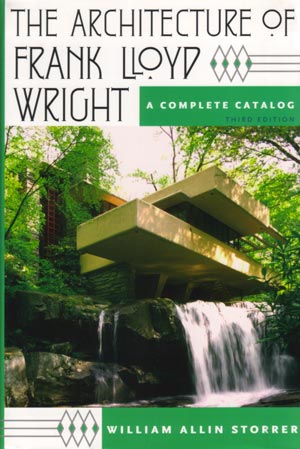The Architecture of Frank Lloyd Wright
A Complete Catalog
by William Allin Storrer
1974; third edition 2002
512 pages
 The Architecture of Frank Lloyd Wright: A Complete Catalog by William Allin Storrer may be used as a field guide as well as a reference. To stay within the compass of a standard-size book, Storrer provides one page per building of Wright's, occasionally two or more pages for a multi-building site. It has semi-stiff durable covers for "field" convenience, but its heavy, quality paper make it a very solid handful.
The Architecture of Frank Lloyd Wright: A Complete Catalog by William Allin Storrer may be used as a field guide as well as a reference. To stay within the compass of a standard-size book, Storrer provides one page per building of Wright's, occasionally two or more pages for a multi-building site. It has semi-stiff durable covers for "field" convenience, but its heavy, quality paper make it a very solid handful.
Storrer provides a short but clear opening essay, "Shaking Houses Out of His Sleeve: The Hidden Legacy of Frank Lloyd Wright". He describes the features of successive Victorian, Prairie, and Usonian styles in Wright's design evolution as the architect worked to invent the "Democratic American Architecture". A revealing clue from Wright's childhood is the Froebel Gifts and Occupations, from the mid-19th Century used as an aid to raising systematically creative children. The catalog itself we may see as a schooling book; and not only for the visible architecture.
It is easy (and enjoyable) to follow the progression in the Complete Catalog, and cross-referencing is standardized:
The works are numbered from 000 to 433 to suit this digital age, are essentially in chronological order of construction, and are prefixed with "S." because this is the Storrer Catalog of the Built Work of Frank Lloyd Wright.
Where building dates lag notably behind Wright's initially undertaking the designs, Storrer makes this clear — and some projects suffered years of delays for various reasons.
Although Wright (1867-1959) is a nationwide architect (with excursions to Japan), we should remember that he also is strongly centered in the Chicago area and the Upper Midwest of America; a quarter of all his buildings are in Illinois. Storrer provides addresses and 55 pages of maps to help the reader precisely locate all existing buildings. He has updates and other discussion online at Frank Lloyd Wright Info.
What might you find surprising in the Complete Catalog? To me, it is the page after page of single-family houses, in city, suburban, and rural settings. Wright designed a number of famous office complexes such as the Johnson Wax Building and Tower in Racine (built in 1936 & 1944; S.237 & S.238), college and museum buildings and so on, commercial interiors, and one lone U.S. Government building (the Marin County Post Office, built in 1957; S.415). But what we mostly see are hundreds of strikingly attractive homes, a grand sequence of Americana.
Storrer draws our attention to repeating elements and evolutions in Wright's designs, special features and materials, and the sitings in harmony with the landscapes.
A definitive, informative, and beautiful book.
© 2005 Robert Wilfred Franson
Great Buildings Collection:
Frank Lloyd Wright
Frank Lloyd Wright Building Conservancy
SaveWright
Froebel Today
Froebel Education for Today's Child
Frank Lloyd Wright Trust
Froebel Blocks In-School Workshops
Schooling at Troynovant
school, college, ongoing learning
| Troynovant, or Renewing Troy: | New | Contents | |||
| recurrent inspiration | Recent Updates | |||
|
www.Troynovant.com |
||||
|
Reviews |
||||
| Personae | Strata | Topography |
|
|||